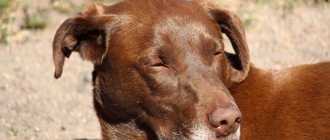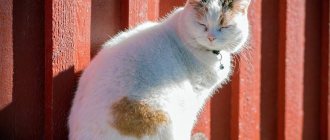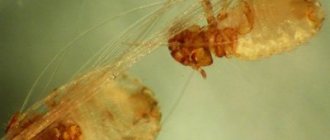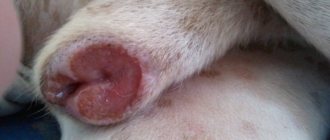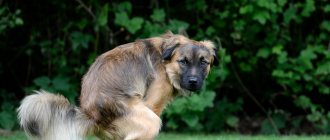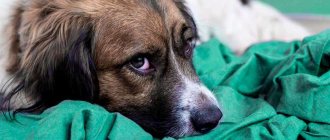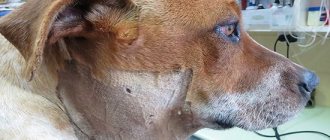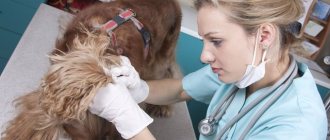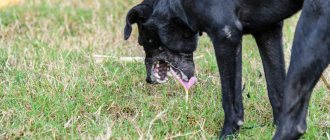Mastitis in dogs is an inflammation of the mammary gland, which often occurs after childbirth, but also occurs in nulliparous bitches, as well as in male dogs. The pathology is dangerous because it can cause blood poisoning, gangrene, benign tumor, and other problems. Therefore, if you find a lump on your animal’s chest, immediately call a doctor who will prescribe treatment for mastitis in your dog.
Causes of mastitis in dogs
The main cause of inflammation is stagnation of milk, which arose due to poor emptying of the gland during feeding (lactostasis). The problem occurs not only in females who have given birth to 2-3 puppies. It appears if the cubs are taken from the breast early or the entire litter has died. Stagnation is possible in mothers with many children who are feeding 12 babies if the babies ignored one of the nipples and the owner did not put them near the problem gland.
The alveoli that produce milk, with poor suction, expand and compress the ducts, which is why the liquid stops flowing normally. This leads to enlargement and hardening of the gland area. Stagnation is an ideal environment for bacteria. Over time, they enter the milk and begin to actively develop, causing inflammation.
The situation worsens if bacteria that cause decay (Staphylococcus aureus) penetrate into the mammary glands through injuries and microcracks. The disease progresses quickly, is acute, requires antibiotics and expensive treatment.
The fibrocystic form occurs after 6 years of age due to hormonal imbalances, and also if the bitch constantly gave birth and raised puppies. This variety can also be found in males. Fibrocystic mastitis rarely develops into a malignant tumor.
Main causes of the disease
The main cause of the disease is a bacterial infection that develops independently or against the background of other diseases. The likelihood of infection increases with weakened immunity caused by:
- chronic pathologies;
- hypothermia or overheating (especially dangerous for hairless breeds);
- persistent helminthiasis;
- poor nutrition;
- postoperative complications.
Inflammation can also occur due to hormonal imbalances (false pregnancy) and diseases of the reproductive organs (endometritis, pyometra). The risk group includes uncastrated animals and pets that produce offspring too often.
Often the growth of bacteria provokes lactostasis, that is, stagnation of milk. This disorder occurs when natural pumping is impossible, typical for the following situations:
- too early weaning from the mother;
- small litter;
- mass death of puppies;
- persistent ignoring of individual nipples during feeding.
The risk of infection also increases with teething. Without calculating the force, babies can injure the sensitive skin of their mother's nipples. Their sharp claws may also be to blame.
Symptoms of mastitis in dogs in a female who has given birth
The sooner the owner notices the symptoms of mastitis, the higher the chances of quickly getting rid of the problem. The advanced form is difficult and expensive to treat.
What does mastitis look like in a dog at a mild stage?
When milk stagnates, a lump appears in the mammary gland. Consult your veterinarian. If the initial phase, the milk has not yet spoiled, there are no foreign impurities, it will be enough to add puppies, which will suck out the excess liquid.
Mastitis in a dog: signs of complications
If the problem is ignored, swelling appears, the lump turns red, and begins to hurt. But the presence of fever depends on the form and stage of the disease. If the pathology is not treated, the inflammation will increase. Symptoms:
- The body temperature is high, the gland is hot to the touch.
- The nipple is enlarged.
- Feeding is painful, the bitch does not allow the puppies to approach the nipples.
- Traces of pus are visible in the milk, sometimes with blood. In this case, the offspring is transferred to artificial feeding. Contaminated milk can poison the babies.
- The tumor grows, the skin turns red, becomes inflamed, and pain appears when trying to touch the tumor.
- The lymph nodes near the diseased area enlarge - round, dense lumps appear under the armpits and in the groin area.
If nothing is done, the lump softens and pus enters the bloodstream, causing infection (abscess). In parallel, gangrene develops - tissue necrosis, which must be removed surgically. Failure to treat will result in the dog's death.
Diagnostics
First of all, an examination by a veterinarian is required. Your doctor will be able to suspect mastitis or even make this diagnosis at your appointment. However, to find out the cause and select the optimal treatment regimen, tests and possibly an ultrasound will be required:
- A clinical blood test will help to understand how acute the inflammatory process is.
- Cytology and Gram stain of milk. It is important to conduct a separate examination of each breast, since inflammation can spread to them with different intensity. Quite often it happens that only a few milk bags become inflamed (for example, due to injury), and the rest of the glands are healthy, and even puppies can be allowed near them.
- Ultrasound of the mammary glands. In case of voluminous compactions, an ultrasound may be required, thus it will be possible to understand whether cavities have begun to form that need to be treated surgically.
Symptoms of mastitis in dogs with false pregnancy
If the bitch has not been bred, she may start producing milk 2 months after her heat. A couple of drops is no reason to worry. If it flows profusely, monitor the dog’s condition and palpate the chest regularly. The pet may be depressed, fever and other symptoms of inflammation will appear.
If a lump appears on the mammary gland, consult a doctor immediately. Since the main reason is a malfunction of the endocrine system, the veterinarian will prescribe hormonal, anti-inflammatory drugs.
What should you do if your dog’s mastitis recurs every time it’s falsely pregnant, and you’re not going to breed it? Spay your pet. This will not only save you from problems with inflammation of the mammary gland, but will also prevent cancer of the genital organs, pyometra (purulent inflammation of the uterus).
Tips for dog owners
A newly whelped bitch requires special care. At this time, her body is especially vulnerable.
If the animal is kept outdoors, then you need to insulate its enclosure with your own hands. It is important to ensure that the litter is dry and clean. When they become dirty, they should be changed.
With the onset of cold weather, you need to curtain the opening to the kennel with thick fabric, which can protect the animal from the wind.
An apartment dog needs to be provided with a place suitable for both the mother and her puppies. The location should not be in the kitchen or bathroom. You cannot place your dog on the doorstep because there is constant draft from the door.
Symptoms of fibrocystic form
The fibrocystic form is often a complication of normal mastitis that occurs in dogs after birth. But this form of mastitis can also occur in a nulliparous dog after a false pregnancy and other conditions that provoke a hormonal imbalance.
Symptoms vary:
- The tumor may be hot to the touch and granular. The formations are round in shape, mobile, and do not cause pain.
- Ichor is released from the nipple.
- The pet is clearly experiencing discomfort in the mammary glands and is trying to lick it.
- The animal refuses to eat, gets tired quickly, and behaves apathetically.
- The temperature rises, and hair falls out on the affected area.
A benign tumor can develop into oncology, so be sure to consult a doctor and get treatment.
What is mastitis
Pathology is a gradual increase in the size of the mammary glands. The inflammatory process can spread to only one pair - or to all five at once.
It is very easy to notice such changes. The problem is that this disease has several varieties. Each of them is treated in a different way, so you should not try to cope with the problem on your own. At best, your efforts simply will not bring results, and at worst, they will aggravate the existing condition.
How to treat mastitis in a dog
Take your dog to the vet as soon as you notice a lump on the gland. After examining your pet, the doctor will tell you how to cure mastitis in a dog.
If this is not possible, the symptoms are mild (no temperature, the formation is not hot to the touch), to treat mastitis in a dog at home, you need to do the following:
- If your pet has long hair, trim it around the nipple.
- Apply puppies to the nipple where mastitis has formed in a nursing dog. Before doing this, check the quality of the milk. It should not be mixed with blood or pus. If it has inflammatory discharge (greenish color), there are white threads, transfer the offspring to artificial nutrition, call a doctor.
- Massage compacted areas after thoroughly washing your hands. When the gland softens, slowly express the milk using gentle movements. Don't try to squeeze out all the liquid. It is enough for the swelling to become softer and subside a little.
If the gland is hot, apply a cooling compress. Do not put ice directly on the skin - the animal may get burned. It’s better to make a lotion from medicinal herbs - pour 1 tbsp. sage or chamomile 1 tbsp. boiling water, leave for an hour. When the infusion has cooled, soak a gauze pad in it and apply it to the inflamed mammary gland.
Breast pump for dog
To avoid manually expressing the nutritional fluid, you can make a breast pump for your dog:
- Take a large syringe.
- Cut off the tip where the needle fits onto the syringe, making a wide hole.
- Carefully heat the cut edges so that the edge becomes smooth and does not injure the skin.
The device is pressed hermetically to the pet's nipple and milk is pumped out, after performing a massage. During the procedure, the dog can stand or lie down. There is no need to put pressure on your pet's chest in an attempt to squeeze out milk or sharply pull out the piston. You can seriously injure the dog and give it bruises.
At first it will be difficult to express, so you need to take a little, with slightly rocking movements, simulating sucking. Then the amount of expressed milk can be increased.
Treatment
The initial diagnosis is made by the dog owner. If you notice something is wrong during pregnancy, you can try to solve the problem on your own. When you discover inflammation of the udder in a lactating dog, entrust the treatment of mastitis to a specialist. Most often, the problem is that the bitch stops allowing the puppies, which can result in the death of the cubs.
How to help a dog at home?
You can treat mastitis yourself if the pathological condition is detected in a non-lactating female. When there is no pus, severe swelling, or hardening, try the following healing techniques:
- Gently massage the nipple with hands previously treated with an antiseptic;
- apply cold decoctions of sage or calendula;
- apply antiseptic ointments - gentamicin, Levomikol, suspension for the treatment of mastitis in ruminants - Sinulox;
- To prevent cracking of the nipples, use Zorka cream.
To enhance immune protection, inject Maksidin, Immunofan or Gamavit. I recommend the first of the drugs, since it is the one that has an anti-inflammatory effect.
If all the puppies have died, or the bitch has developed a false pregnancy, camphor oil is applied to the udder and bandaged tightly. However, I recommend a different method, which I will discuss in the next section.
Professional help
Diagnosis consists of a clinical examination and history taking. Particular attention is paid to false pregnancies that have occurred. In case of repeated pathology, it is recommended to castrate the bitch. If false pregnancy is diagnosed, then exclude all dairy foods from the diet or switch to ready-made food for obese dogs. Restricted feeding with low caloric concentrations results in a cessation of milk production.
Additionally, add Galastop or Lacto-Stop emulsion. To prevent vomiting, first inject Cerucal.
What to do if a dog’s mastitis turns into a purulent or fibrinous form? The treatment regimen is developed in the following areas:
- Lactation is stopped in the same way as during imaginary pregnancy.
- The puppies are taken away and put on artificial feeding with a bitch milk substitute.
- To interrupt pathological signals along the nerve trunks, a novocaine blockade is carried out, as a result of which pain decreases and the inflammatory process stops.
- To suppress the activity of bacterial microflora, use injectable antibiotics and wound-healing anti-inflammatory drugs. Mastitis pathogens are most sensitive to penicillins. Therefore, Sinulox or Xiclav is prescribed internally. For external treatment, use suspensions for intracisternal administration to cattle - Sinulox or Tetra-delta.
Giving the puppy milk replacer.
In advanced cases, they operate: open the abscess, release the pus, and treat the purulent wound. The pathological cavity is washed with antiseptics: Furacilin, Chlorhexidine or the drug Monclavit 1. Stitches are applied or dispensed with. To speed up healing and drying, use Tetracilin, Ranosan or Tsamax powders. Don't bandage it: the bitch will rip off the bandages anyway. Therefore, spray aerosols on seams or skin defects: Aluminumspray or Chemi-spray, which form a protective film. The result is a gauze-free bandage.
If a tumor is suspected, the veterinarian selects pathological material for histological examination. When cancer is detected, a decision is made on what to do - castrate the animal with removal of the reproductive organs and mammary glands, or carry out chemotherapy.
If mastitis is diagnosed in a resting female dog or in a male dog, the defects are treated with antimicrobial sprays.
Preparations for canine mastitis
To treat udder inflammation in dogs, veterinarians recommend the following medications:
Galastop
Made in France. The active component is Cabergoline, which is similar to the ergot alkaloid ergoline. Inhibits the secretion of the hormone responsible for lactation. Give in a dose of 1 ml/10 kg of weight for 4-6 days in a row. Lactation stops.
Price 1740 rub.
Lacto-stop
The Russian-made drug is similar in action and composition to the drug Galastop. Before use, Cerucal is injected to prevent vomiting in case of a possible overdose. The course of treatment is 5 days, a single serving is 30 drops/10 kg of weight.
Cost 1470 rub.
Maxidin
Immunomodulator, enhances the immune response to infectious agents. Helps stop the inflammatory process. Administered twice a day intramuscularly or subcutaneously in an amount of 1 ml/5-10 kg of weight. The course of treatment is from 2 to 5 days.
The cost of the bottle is 85 rubles.
Sinulox
The tablets are a combination of Amoxicillin and clavuanic acid. The additive does not allow the microflora to develop immunity to Amoxicillin. 250 mg tablets are given twice daily, one per dog weighing 18 to 25 kg. For smaller animals, pills containing 50 mg of active substance are provided. The course of treatment is from 5 to 7 days.
The cost of packaging is 340 rubles.
Sinulox intracisternal suspension
The contents are squeezed out of the dispenser syringe onto the affected surface. The duration of treatment is limited by the volume of the syringe. In clinical settings, an injection form of the drug with a volume of 40 ml and a cost of 1015 rubles is used.
The cost of a dispensing syringe weighing 3 g is 130 rubles.
Chemi spray
The active ingredients are the antibiotic Chlortetracycline and the antifungal agent Gentian violette. Clean the damaged surface from crusts and apply the spray 1 to 3 times a day until complete healing, but no more than 10 days.
Cost 490 rub.
Brit care puppy milk
Bitch milk substitute. Mix one volume of powder with three parts water, heat it in a bath to 39 ° C, and drink it from a pipette or bottle. The serving size for a puppy and the feeding frequency are indicated on the package.
Cost 0.5 kg - 1222 rubles.
When to see a doctor urgently
If the dog is clearly unwell, there are signs of inflammation, it is lethargic, or has lost interest in puppies - immediately consult a veterinarian. If you live in a regional center and the nearest clinic is 30 km away, take a car and take your animal. You can also ask the doctor to come home and pay for the trip.
Call your veterinarian if:
- high temperature (more than 38.5°C);
- the affected area is hot;
- in milk - small pieces of yellow or greenish color, an incomprehensible cloudy liquid;
- long white threads stand out from the nipples;
- the lymph nodes under the arms and in the groin area have enlarged;
- purulent, inflamed areas appeared on the skin, blackness similar to bruises (a symptom of gangrene).
Complications and dangers of the condition
Late diagnosis and self-treatment are fraught with the growth of abscesses and gradual tissue death. In addition to complications of the existing form, damage to other organs is possible with the following consequences:
- malignant neoplasms;
- sepsis;
- infectious-toxic shock;
- acute intestinal disorder;
- pyometra;
- loss of reproductive function;
- inflammation of the spinal cord.
Ultimately, the animal may die, so do not delay in contacting the veterinarian. The sooner treatment is started, the faster and easier the recovery will be.
Veterinary care for inflammation of the mammary glands
For mastitis in dogs, treatment depends on the stage of the disease. If the situation is not critical, the doctor will prescribe medicinal ointments for mastitis for dogs, which will help relieve inflammation. The doctor prescribes the following medications to treat mastitis in dogs:
- Mastometrin - a medicine for mastitis in dogs eliminates pain and inflammation.
- Antibiotics (Ceftriaxone, Amoxicillin) – for mastitis in a bitch, they are prescribed for treatment to destroy the bacterial infection.
- Fosprenil is an immunomodulator that increases the body's resistance to disease.
- Novocaine blockades - eliminate pain.
In extreme cases, the doctor resorts to surgery - he opens the abscess, removes dead tissue, and installs a drain to drain the pus. If gangrene has occurred, he may remove the affected gland in whole or in part.
Veterinarian's findings
I believe that mastitis in bitches occurs due to oversight and erroneous actions of the owners. Savings on housing conditions and food result in disproportionately large treatment costs and lost profits due to the death of puppies. Therefore, equip a comfortable den and organize proper feeding.
Puppies and especially lactating females are voracious. A lactating bitch needs three times more calories than an animal in a state of sexual rest. Therefore, the feeder must be constantly full. Otherwise, there will not be enough energy to produce milk, and hungry puppies will bite the udder.
Refrain from using hormonal drugs to disrupt pregnancy and suppress heat. If heat is approaching and the owner does not intend to breed the bitch, you need to contact a veterinarian and use contraceptives under his supervision.
If, despite all efforts, mastitis still occurs, the first thing you need to do is stop lactation. Wean puppies to avoid digestive disorders. Therefore, purchase a bitch milk substitute just in case. If the period of use expires, the food will be consumed with pleasure by an animal of any age.
To stop lactation, the drug Galastop is best suited. At the same time, switch the animal to one-time feeding and limit drinking. Give water three times a day and when the bitch has drunk. Remove the bowl immediately.
If there are few puppies and there is a lot of milk, express and limit food intake, switch to veterinary nutrition to reduce weight.
If a false pregnancy occurs, select and hide soft toys and slippers, which the bitch will mistake for puppies. Do not express milk, this will stimulate lactation. Treatment is the same as for a small number of puppies. Limiting feeding and drinking often helps, without the use of medications that stop milk flow.
Prevention of mastitis in dogs at home
- Make sure the babies suckle from all teats.
- Feel your dog's chest regularly. If you find mastitis in a nursing bitch, consult a doctor immediately.
- If you do not plan to breed the bitch, spay her.
- Treat all wounds with antiseptics.
- For any illnesses, consult a doctor, as they can cause inflammation of the mammary gland in nulliparous females and males.
- Feed your pet high-quality food.
- Do not keep your dog in the cold or in drafts.
- Wash your pet's bedding regularly.
- Don’t forget about vaccinations, antiparasitic and anthelmintic medications – the immune system of a healthy animal copes better with inflammation.
